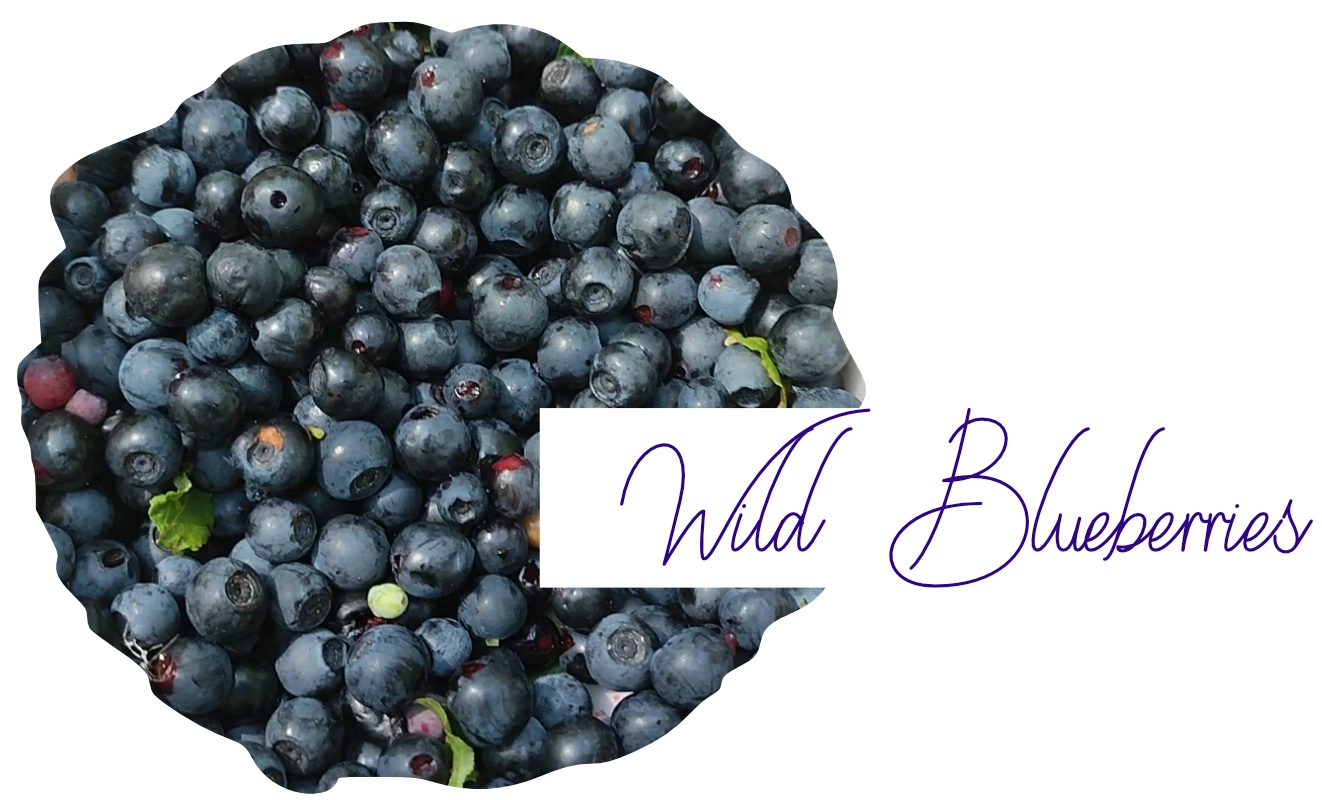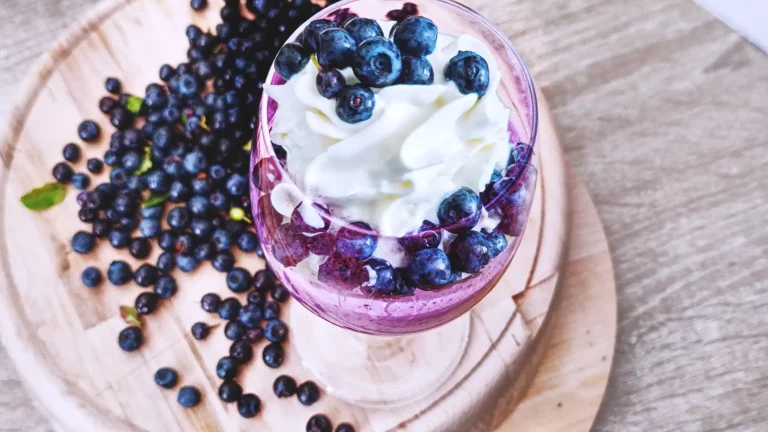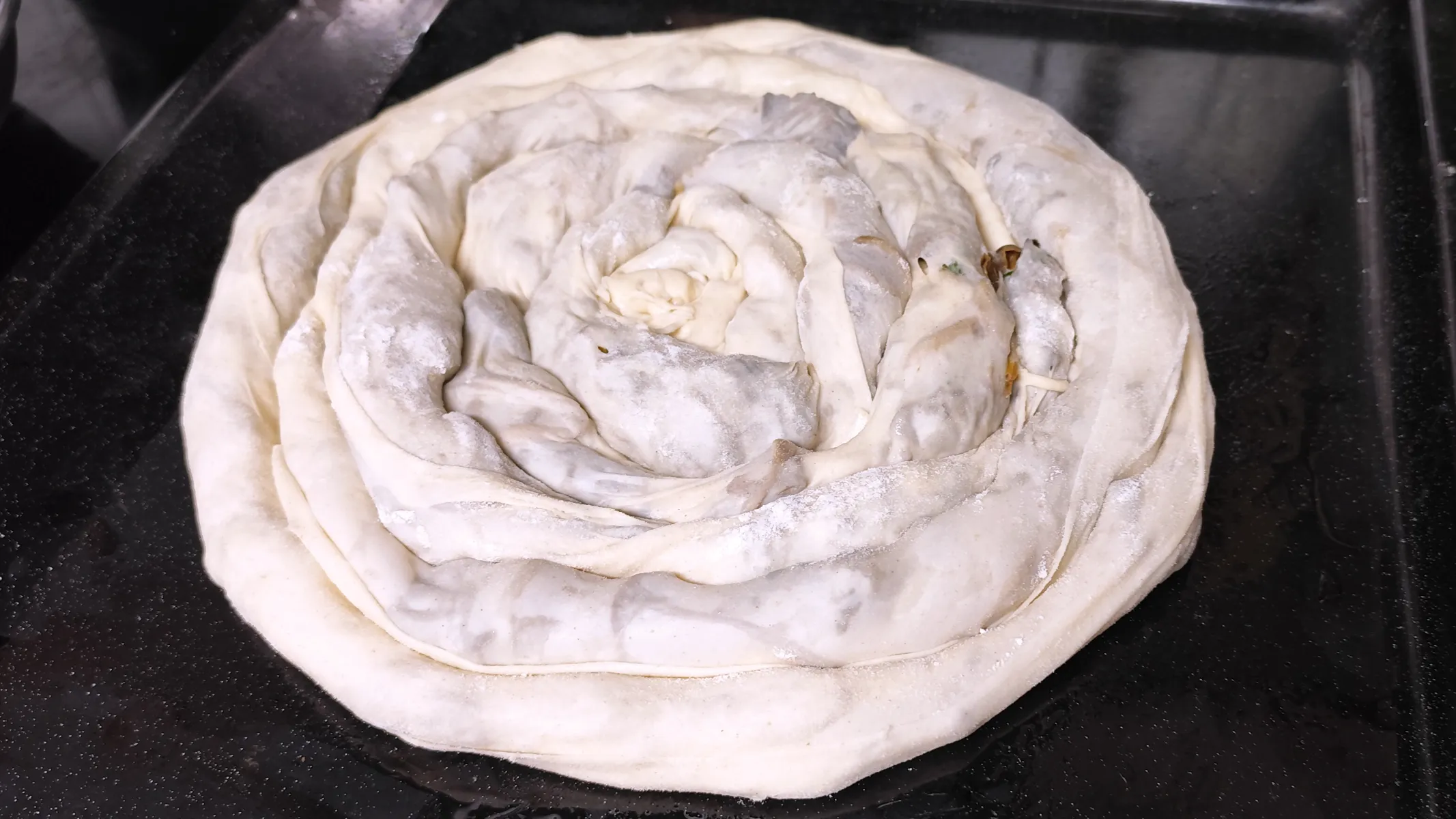Learn About Wild Blueberry Benefits, Safe Foraging, and Tasty Recipes. Discover the Nutritional Benefits of Small Wild Blueberries and the Contrasts with Cultivated Blueberries.
Table of Contents
Beyond the taste, wild blueberries have health benefits that can really improve our overall health, and you can make delicious recipes like this Italian Panna Cotta or Lemon Blueberry Cookies.
Even though Wild blueberries are small, wild blueberries pack a powerful nutrition punch. Their strong flavour comes from more nutrients and good things compared to bigger farmed blueberries.
Wild blueberries naturally have less sugar but more fiber, iron, minerals and good amazingly higher antioxidant capacity.
Wild blueberries are also known for their good antioxidants. Research shows eating wild blueberries may help lower the risk of diseases like heart disease, diabetes and age-related thinking problems.
For a tasty twist, try this vibrant Blueberry balsamic dressing — a perfect way to make the most of wild blueberries.
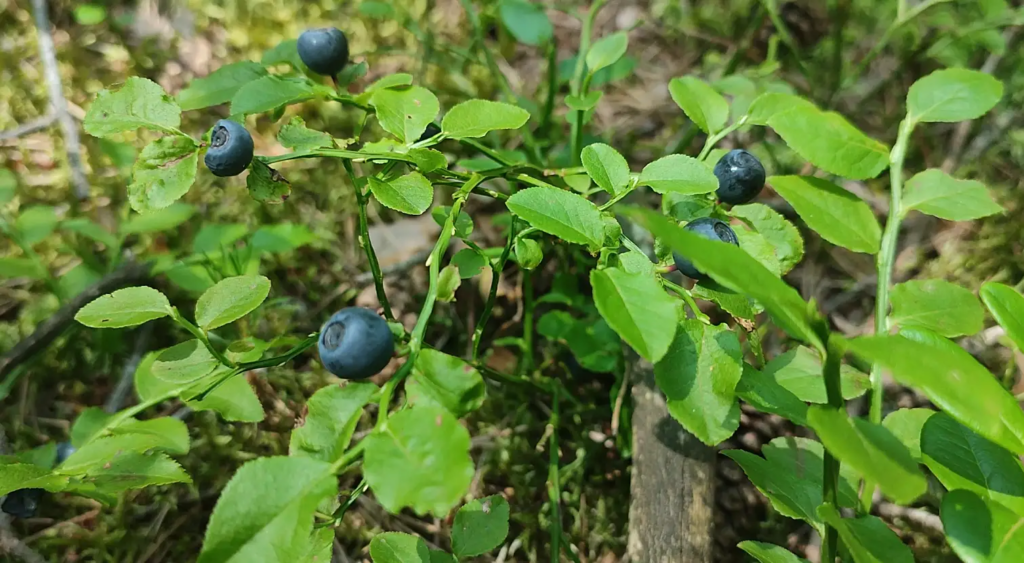
We live off the bushes
My family and I spend most summer days and late fall weekends in near forests collecting blueberries, plants, flowers, and mushrooms and preparing for winter sleep :). We joke that we “live off the land – or should I say off the bushes!”.
Next time you are in the woods, look for the small but really good wild blueberries. Their special appeal comes not just from taste but also from the promise of real health benefits in such a small package.
Grab a handful and enjoy this little fruit with the big effect on your well-being.
Spotting wild blueberries in nature is easy once you know what to look for.
Thanks to their resilience, they thrive throughout forests and fields. Taking a few minutes to familiarize yourself with their identifying traits is worthwhile since next time you’re walking in the woods, you’ll recognize the telltale signs and feel confident harvesting some for yourself.
Identifying wild blueberry plant
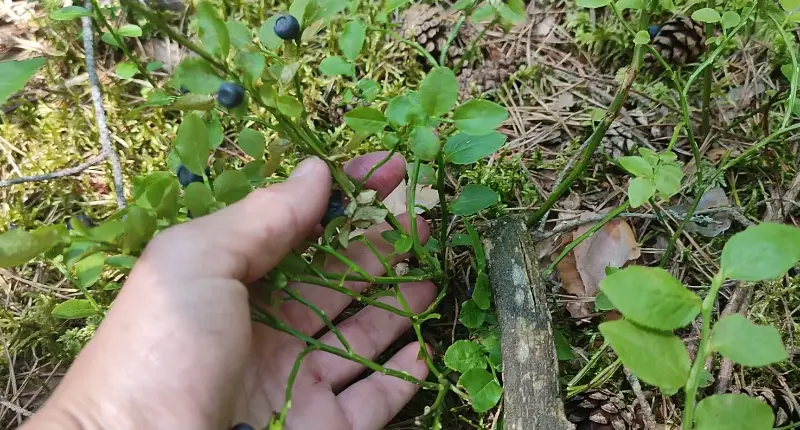
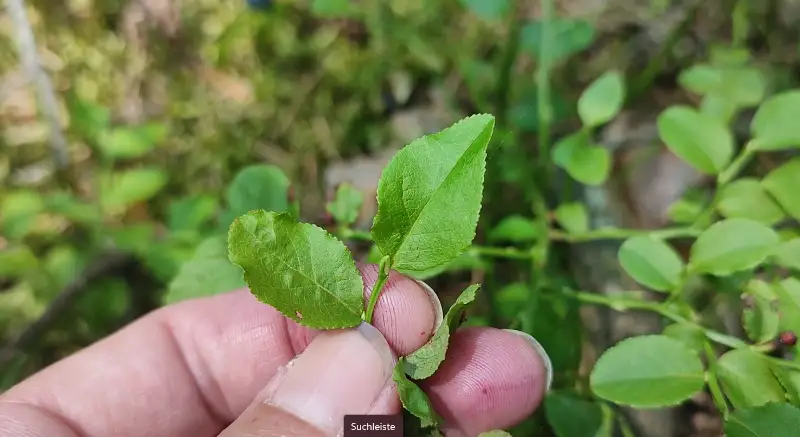
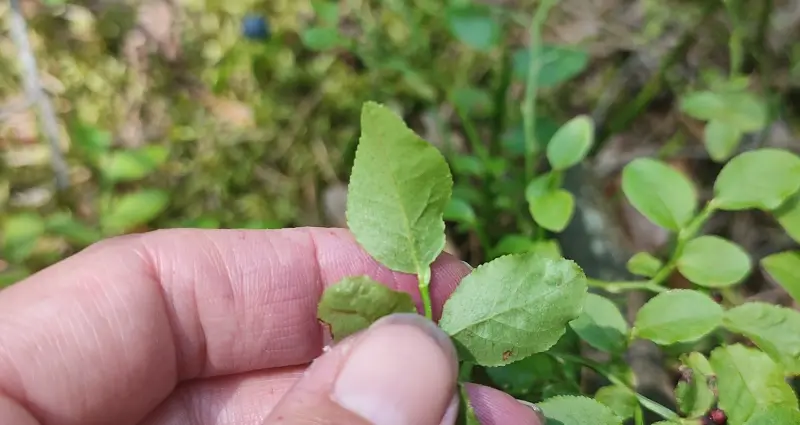
Armed with this basic knowledge of wild blueberry plants, you’ll be surprised at how quickly you’ll start spotting them on your next woodland walk.
Carefully examine any low-growing shrubs with oval leaves and fine-toothed edges. Look for the slender stems holding tiny pink or white blossoms in spring. And scan the ground for small round fruits with a blueish coating. With a little practice, harvesting wild blueberries will soon become second nature.
Wild blueberries distinct characteristics
- Wild Blueberries grow in low, spreading bushes. The stems are slender and flexible and can grow to about ca. 50cm (16 inches) tall.
- Their leaves are oval or elliptic in shape with finely toothed edges.
- Top side of the leaves has a glossy green surface and a pale underside.
- The flowers typically bloom from May through June and are white or pinkish in color with 5 petals.
Where do most wild blueberries grow?
Wild blueberries thrive in acidic soil, often found in areas such as open forests, and rocky hillsides. They are adapted to withstand harsh climates and are commonly found in regions with cool temperatures.
Physical features of Wild Blueberry
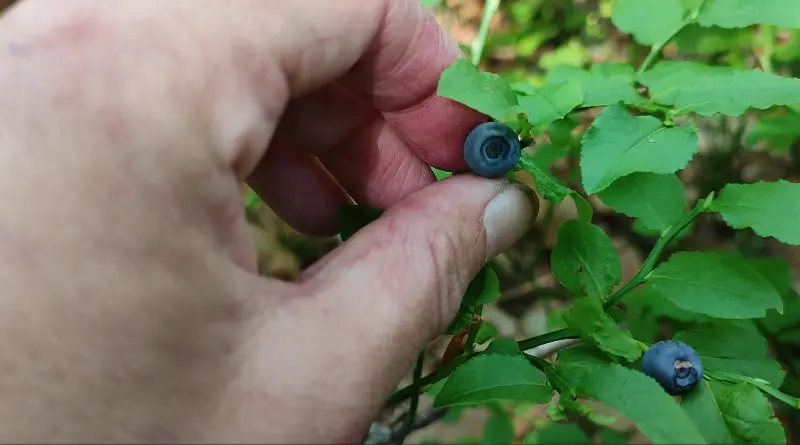
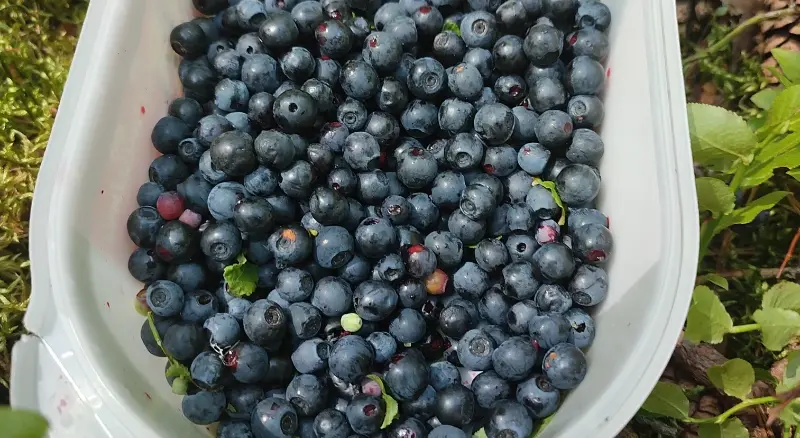
- The fruits are the most distinctive feature. Wild blueberries are smaller than cultivated varieties, usually around 0.5cm – 1cm in diameter.
They have a round to oval shape and start out green, turning dark blue when ripe. The skin is covered in a visible whitish wax coating known as the bloom, which protects the fruit from excessive moisture loss. - Wild blueberries feature a deep blue or purple skin and a juicy, sweet-tart flesh. They grow in low, spreading bushes, and their berries cluster together, forming an abundant harvest during the peak season.

In short: The typical characteristics of the fruits are:
- Spherical shape of berries
- Dark blue / bluish-black color
- Powdery bloom
- Red / bluish-red flesh
- A dwarf shrub that bears multiple fruits per stem.
- Low spreading bush
- Green oval leaves, with finely toothed edges.
Wild Blueberry Doppelganger: Foraging Risks
When out gathering wild blueberries, it is essential to be mindful of comparable plants that may be dangerous or inedible.
Mixing up toxic plants for wild blueberries can result in detrimental health effects. Some plants can cause digestive issues, while others can be harmful or even deadly if consumed. It is absolutely critical to take precaution and thoroughly make oneself acquainted with the attributes of wild blueberries before harvesting.
So take your time, observe closely and confidently gather only those berries you are absolutely certain belong to the wild blueberry genus.
Atropa belladonna (Deadly Nightshade) – Toxic
Deadly nightshade is an incredibly dangerous plant. Ingesting even the tiniest amount can be fatal. As few as 3 to 5 berries can take the life of a child, while for grownups 10 to 20 berries can be a lethal dose. Its toxicity differs depending on location.
Typical symptoms of deadly nightshade poisoning involve dilated pupils, absence of vomiting, dry and flushed skin. Dehydrated membranes in the mouth and throat may induce difficulties speaking or swallowing plus a heightened pulse. In severe cases, the person may become restless, cry excessively, chatter persistently and undergo fits of rage. In the direst poisonings, the individual could lose consciousness and expire from respiratory paralysis. The deadly nightshade plant is toxic not only to humans but also many animals.
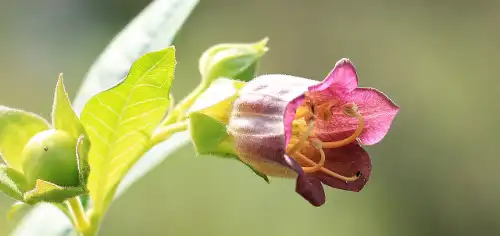
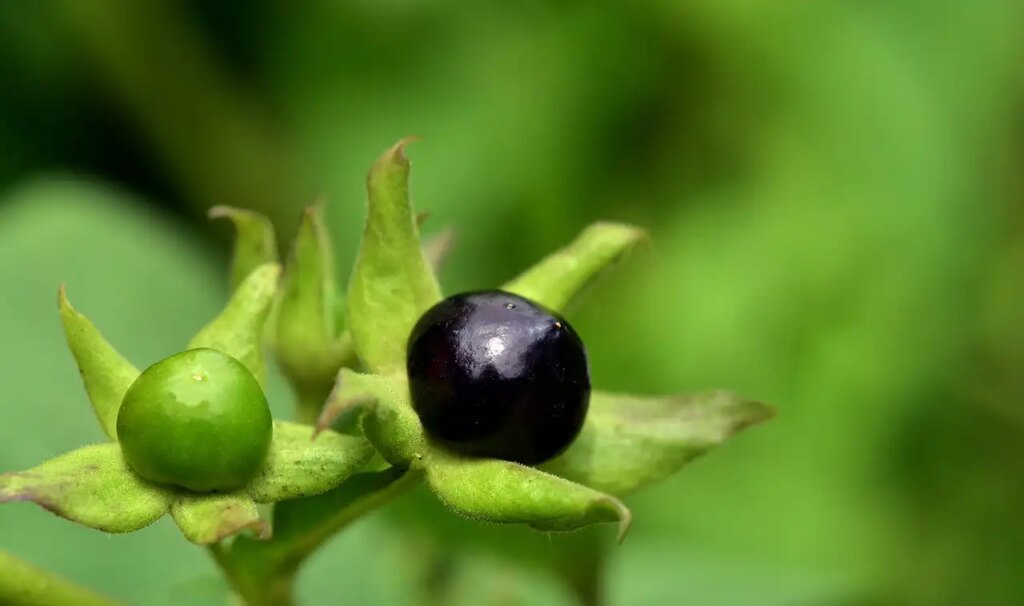
Deadly nightshade possesses 5-petaled, bell-like blooms which are brownish-purple on the exterior and yellowish-green inside. The blossoms can develop up to ca. 3cm (1.2 inches) across and individually sit amongst the upper foliage. These leaves are egg-shaped and taper towards the stem.
Generally, a little and a mighty leaf are found together. The plant can stretch to around 5 feet in height.
In short: The typical characteristics are:
• 5 petaled, bell shaped flowers
• Brownish-purple outside, yellowish-green inside
• Ovate, tapered leaves
• Small and large leaves found together
• Plant height up to 5 feet
Deadly nightshade blooms from June through August and generates glossy, cherry- sized berries that are black in color. The berries are approximately 1cm to 1.5cm in diameter. Deadly Nightshade sits upon a comparatively short, thick stalk and has a wide, embracing calyx.
Deadly nightshade thrives in warm forest edges, openings and clearings as well as in open spaces of deciduous and mixed woodlands. It prefers humus-rich, somewhat alkaline soils.
How to recognize Deadly nightshade:
• An upright, branched herb reaching a height of nearly 1.5m (5 feet)
• The stem is reddish-green, softly hairy and branched.
• The leaves are grayish-green, hairy and oval to lance-shaped.
• The blooms are usually violet and bell-shaped.
• The berries are blackish purple and resemble cherries
Paris quadrifolia (Herb Paris or True lover’s knot) -Toxic
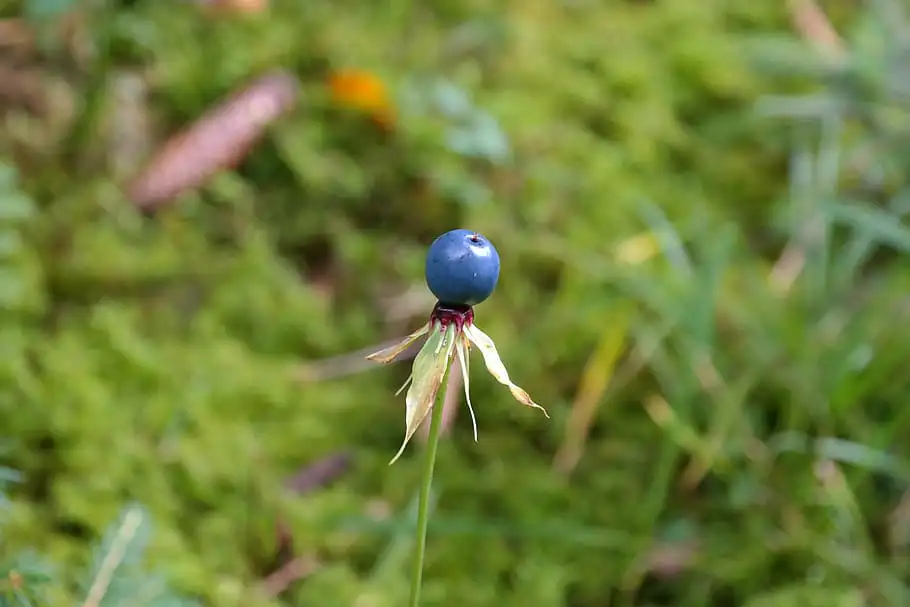
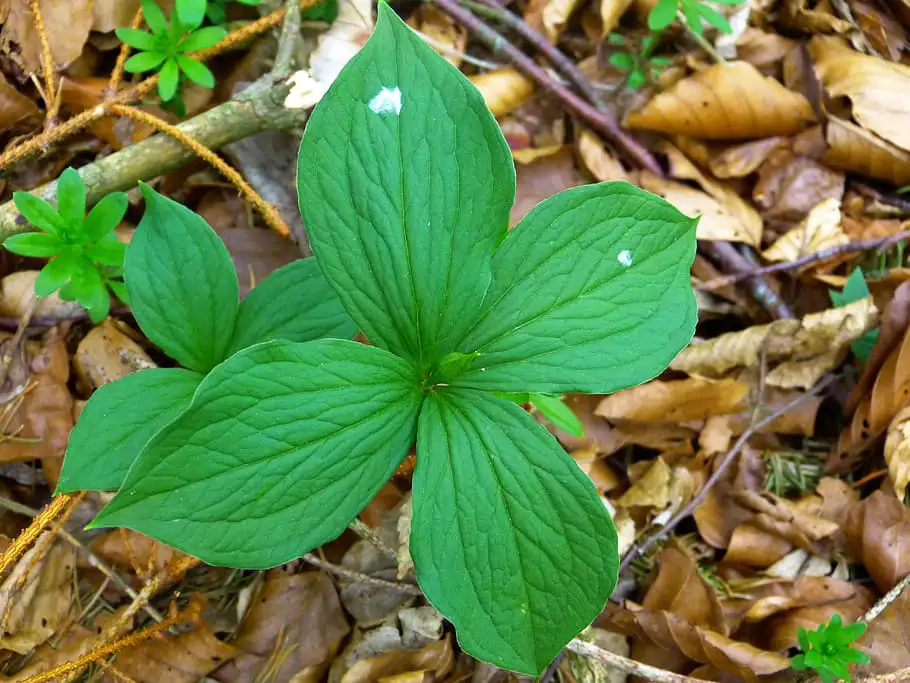
Herb Paris is a rather distinctive plant. It ordinarily has 4 foliage arranged in a circular configuration below a terminal blossom. At the core of the green petals is a dark blue-black ovary which develops into a cherry-sized drupe, also blue-black, from August onwards. The plant expands to a height of 6 to 10 inches and blooms from May through June.
Herb Paris thrives in deciduous and mixed woodlands, on well-drained, nutrient-rich soils. It is located throughout Europe, except in the westernmost and southernmost areas.
Intoxication is characterized by queasiness, dizziness, and diarrhea. It can also result in pupil dilation and headaches. The plant is not merely detrimental to humans but additionally to many animals.
Vaccinium myrtillus (Bog bilberry)
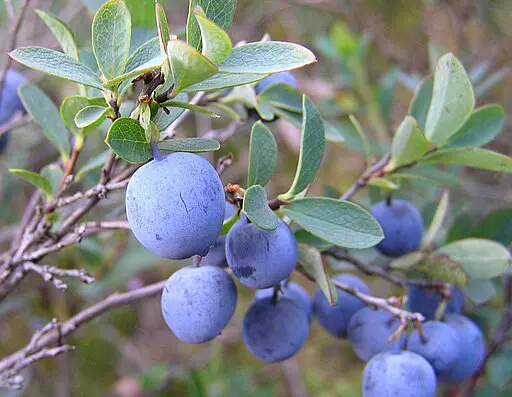
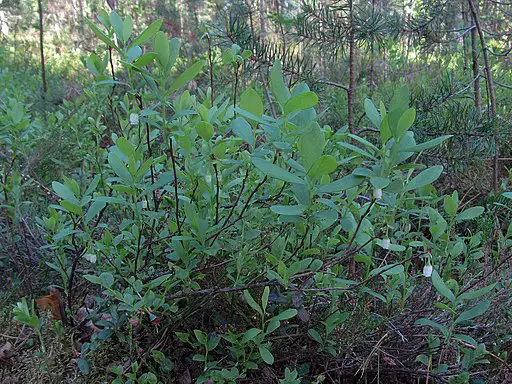
There are notable distinctions between bilberries and blueberries regarding their berries and foliage. While both kinds of berries have a blueish hue, bilberries stand out with an icy-looking surface, featuring significant rings in comparison to blueberries. In certain regions, bilberries are also known as cloudberries.
Though bilberries are edible, they are not especially tasty. It’s crucial to note that eating a larger quantity of bilberries may result in a condition resembling intoxication, which is why they are often called “bilberry” or “drunkberry.”
This impact is speculated to be brought on by toxic substances from a parasitic fungus present in bilberries. However, ingesting several berries is normally considered harmless.
In addition to differences in berry appearance, there are variations in the pulp and juice of bilberries and blueberries. Blueberries have blue-colored pulp, while bilberries have pale-colored pulp.
When it comes to the leaves, blueberries have green foliage, oval and angled, while bilberries have bluish-green, oval-shaped leaves with smooth edges.
Caution when foraging
To avoid making mistakes when foraging, use a reliable field guide or consult an experienced forager. Familiarise yourself with the characteristics of local blueberries and compare them with any possible lookalikes in your area. When in doubt, it’s best to err on the side of caution and seek expert opinion.
Any attempt to consume wild plants is at your own risk. The author cannot guarantee that this information is completely accurate or comprehensive.
To gather wild edibles safely and responsibly
- Consult several professionally reviewed foraging guides
- Learn to correctly identify plants based on several distinguishing characteristics
- Start by collecting only known, easily identifiable species
- Research toxicity and similar species for related plants in your area
- Seek direct advice from a professional forager or botanist
- Consume small amounts initially and monitor for adverse reactions
- Do not consume plants that cause discomfort, illness or uncertainty.
In summary, this information alone is NOT a substitute for working directly with foraging experts who can validate your identifications and teach you safe practices. Any foraging attempts based solely on this advice would be unwise. Please forage responsibly and stay safe.
Are wild blueberries good for you? Wild Blueberries Benefits
Wild blueberry naturally has less sugar but more fiber, iron, minerals and good amazingly higher antioxidant capacity. These little berries are known for their good antioxidants.
Five Health Benefits of Wild Blueberries
Research shows eating wild blueberries may help lower the risk of diseases like heart disease, diabetes and age-related thinking problems.
High in Antioxidants
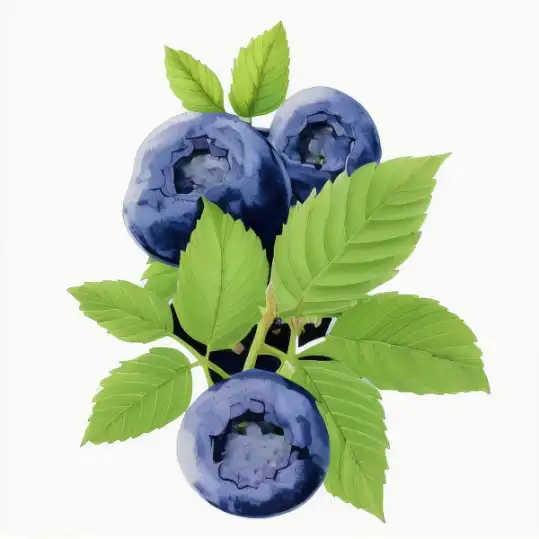
Wild blueberries are rich in antioxidants, specifically anthocyanins, which give them their deep blue color. These antioxidants help protect the body against damage caused by harmful free radicals, reducing the risk of chronic diseases such as heart disease, cancer, and neurodegenerative disorders.
Heart Health

The high levels of antioxidants and fiber in wild blueberries contribute to heart health. Antioxidants help reduce inflammation and oxidative stress, which are risk factors for heart disease. The fiber content in blueberries helps lower cholesterol levels, reduce blood pressure, and promote healthy blood vessel function.
Improved Brain Function

Wild blueberries have been associated with improved cognitive function and brain health. The antioxidants in blueberries may help delay brain aging and improve memory, learning, and motor skills. They also contain flavonoids that may enhance brain cell communication and promote overall brain health.
Enhanced Digestive Health

Wild blueberries are a good source of dietary fiber, which aids in maintaining a healthy digestive system. Fiber adds bulk to the stool, preventing constipation and promoting regular bowel movements. It also supports the growth of beneficial gut bacteria, improving overall gut health and reducing the risk of gastrointestinal disorders.
Stronger Immune System

The antioxidants, vitamins, and minerals found in wild blueberries can strengthen the immune system. They help neutralize harmful free radicals and reduce oxidative stress, which can weaken the immune response. The vitamin C content in blueberries also boosts the production of white blood cells, enhancing the body’s ability to fight off infections.
Nutrition Table for 100g of Wild Blueberries:
| Nutrient | Amount per 100g |
|---|---|
| Calories | 57 |
| Protein | 0.7g |
| Fat | 0.3g |
| Carbohydrates | 14.5g |
| Fiber | 2.4g |
| Sugars | 9.9g |
| Vitamin C | 9.7mg |
| Vitamin K | 19.3μg |
| Calcium | 6mg |
| Iron | 0.3mg |
| Magnesium | 6mg |
| Potassium | 77mg |
| Phosphorus | 12mg |
Here is a nutrition table showcasing the approximate values of key nutrients found in 100 grams of wild blueberries:
Please note that these values are approximate and can vary depending on factors such as growing conditions and ripeness of the berries.
Wild Blueberries vs. Regular Blueberries: A Nutritional Face-off
Comparison
Wild blueberries and regular blueberries are both popular for their sweet, juicy, and antioxidant-rich fruit. However, they have some differences that distinguish them.
Size
Wild blueberries are much smaller than their cultivated rivals. They measure less than half an inch across, while cultivated blueberries often exceed an inch.
Antioxidant & Vitamin Powerhouse
Despite their small size, wild blueberries are packed with nutrients. They comprise higher measures of vitamin C, vitamin K, iron, and manganese, and consist of more vitamins, minerals, and fiber than cultivated blueberries.
Sugar content
If you want to reduce your sugar intake, choosing wild blueberries can be a smart choice. They have a lower sugar content than cultivated blueberries and can be a healthier option for people watching their sugar intake.
Research
Research has proven that consuming wild blueberries offers great health benefits due to their antioxidant and anti-inflammatory properties. To further understand their nutritional content, research can be found on reputable platforms such as the PubMed
In summary, despite being smaller in size, wild blueberries contain a powerful punch of essential nutrients and antioxidants.These berries are a healthy option with less sugar and more fibre. They are a great choice for those who want to improve their diet. Cultivated blueberries are also nutritious, but they are larger and slightly sweeter. Both types of blueberries offer unique benefits. You can enjoy them depending on your dietary preferences and health goals.
Wild Blueberry Recipes
The list of delicious recipes on this blog is always expanding so it’s worth checking back regularly for new blueberry dishes and ideas.
Some classic ways to enjoy wild blueberries are eating them raw 🙂 straight off the bush. Simply pop a handful in your mouth. Other ways include blending them into smoothies, layering them over yogurt or oatmeal, or making with them muffins, strudel, breads, and pancakes. They also pair perfectly with sweet desserts such as ice cream, cakes etc.
But don’t limit yourself to just sweet preparations, you can toss them into salads, mix them into a sauce for meats or stir them into rice dishes.
The possibilities for using wild blueberries in the kitchen are endless.
Amazing Recipes with Wild Blueberry
Can you eat wild blueberries raw?
The list of delicious recipes on turbotasty.com is always expanding so it’s worth checking back regularly for new blueberry dishes and ideas.
Some classic ways to enjoy wild blueberries are eating them raw 🙂 straight off the bush. Simply pop a handful in your mouth. Other ways include blending them into smoothies, layering them over yogurt or oatmeal, or making with them muffins, strudel, breads, and pancakes. They also pair perfectly with sweet desserts such as ice cream, cakes etc.
Recipes with Wild Blueberries form Turbo Tasty web page! Check back here often for more recipe ideas to maximize health potential of these tiny but mighty blueberries.
If you want to try gluten-free blueberry muffins This is the place to go: Abra’s Kitchen, a website that offers easy and healthy recipes for busy people: Gluten Free Blueberry Muffins
Amazing Blueberry Recipes from TinasRecipe Blog: https://www.tinasrecipe.com/
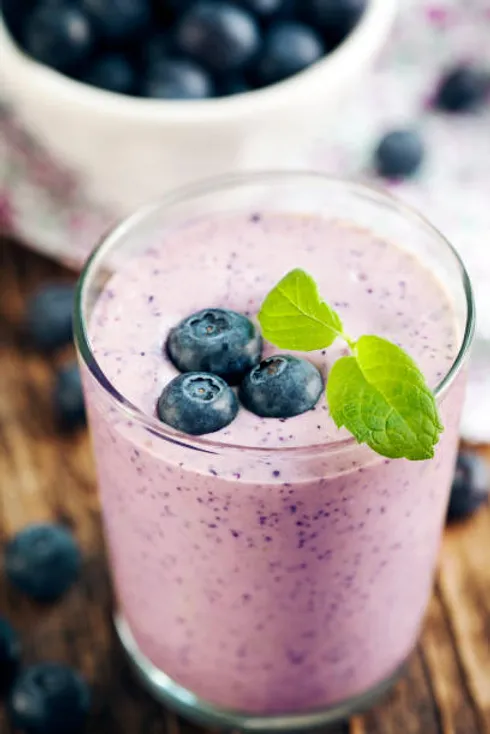
This blueberry smoothie is a quick and healthy breakfast option and an amazing way to use your Wild Blueberry (frozen or fresh blueberries). Super creamy, delicious, refreshing, and kid-friendly!

Blueberry Muffins Recipe
These soft and moist wild blueberry muffins are made with simple ingredients and are perfect for an easy and quick breakfast.
🌐 Sources
- ncbi.nlm.nih.gov – The antioxidant level of Alaska’s wild berries: high, higher …
- ncbi.nlm.nih.gov – Mineral Composition of Wild and Cultivated Blueberries
- ars.usda.gov – Blueberries and Health
Popular Turbo Tasty Recipes


